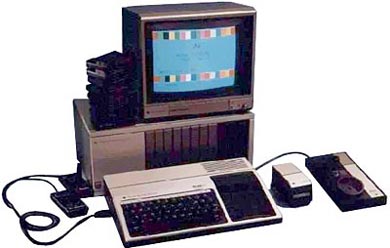The Texas Instruments
TI99/4A home computer was first introduced in 1979 with
a retail price of $525 and was one of the most powerful
of it's time. It was largely based on an earlier design,
the TI99/4, but with various improvements to make it
more desirable to home users. It came with TI BASIC
built in, a very simple to use but powerful programming
language. Unfortunately, due to the internal architecture
of the TI99/4A and the way BASIC was interpreted by
the machine, it was very slow in execution. One of the
reasons for this was because it was originally designed
as a console, with a different CPU than was eventually
installed, rather than a full home computer. If you
could afford the Extended Basic module you would benefit
from much faster execution speed as it was extensively
optimised with assembly language.
Despite the fact that
the TI99/4A was an extremely good computer for it's
time, it was hampered by several factors, not least
of which was TI's very tight controls over third party
software development. Price was also against the TI99/4A
as it was very expensive when first released and had
only limited software support, this also being very
expensive.
The TI99/4A was discontinued
in March 1984 as the home computer market was expanding
very rapidly at that time and there was a lot of competition
from cheaper 8-bit machines. A lot of these machines
were technically inferior to the TI99/4A but had much
better (and cheaper) software support, and, as history
has shown us, it's the software that makes a computer
successful. TI couldn't compete on price as the 99/4A
was quite expensive to produce and in the end, they
had to withdraw from the home computer market due to
financial losses.

In my opinion the TI99/4A
could have been a world beating home computer even into
the mid eighties if Extended Basic had been built in
from the start, it had at least 32K of internal RAM
and TI had allowed third party developers free access
to the operating system and architecture of the machine.
Current Value
According to "Collectible
Microcomputers" by Michael Nadeau, 2002, the TI99/4A
ranges in price from $5 to $20 depending on condition
and completeness. This is due to the fact that although
the TI99/4A was not a great success it was produced
in the millions by TI and so there are still plenty
out there. If you're lucky enough to have a TI99/4 though
(the precursor to the 4A), then it's worth between $50
and $125 because of it's comparative rarity.
Texas Instruments also
produced a stripped down version of the TI99/4A in 1983,
called the TI99/2, which retailed at $99. These are
also quite rare and now have a value between $50 and
$150.
I've given the prices
here in US$ because the book is an American publication
and as such represents the author's research in the
American market. But even given that the TI99/4A is
slightly less common on these shores they still aren't
worth very much as a collectible machine.
L@@K!! Texas Intruments TI99/4A **RARE!!**
Or: Some musings on the subject of eBay auction titles.
Where do you start? OK,
lets take a look at the ridiculous title first of all.
What on Earth does "L@@K" mean? Taken literally
it reads "LatatK", which I can't find in the
dictionary but I'm just being pedantic of course. Presumably
the vendor means "LOOK! I've got what I think is
a really rare and valuable computer and I'm desperately
trying to attract the attention of anyone who'll be
daft enough to give me hundreds of pounds for it!"
(Please refer to the previous item on this page for
values). You really don't need to include this in the
description of your machine do you? I mean, who types
"L@@K!!" as a search term? Item descriptions
littered with un-necessary characters, exclamation marks,
capital letters etc. just remind me of hysterically
overblown and inaccurate tabloid headlines.
The next part of the
title is fine. It says what the auction is for and that's
all you need. I don't need to be told to "L@@K!!"
because I've already done a search for TI99/4a and I'm
already looking now anyway. So we come to "**RARE!!**".
Is it? Is that just because it's the only one you happen
to have in your house right now? Maybe you haven't seen
one for a while? Does that make it rare? Do some research
and you'll see that they're actually quite plentiful.
Or maybe you're just trying to convince potential bidders
that it's rare so you can push the price up? You want
rare? Check out this link about the
Yangtze
River Dolphin. Now that's R@RE!! (sic). The fact
is, TI produced millions of these wonderful little machines
so don't expect vast sums of money to be squandered
in a bidding war for that '99 you found under a pile
of old Christmas decorations in the loft. On the other
hand, the TI Peripheral Expansion Box (PEB)
is
rare. TI only produced a few hundred thousand of these
and I'd gladly donate a limb to get hold of one.

